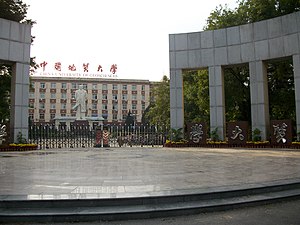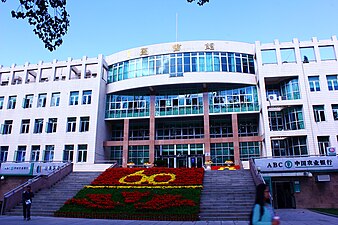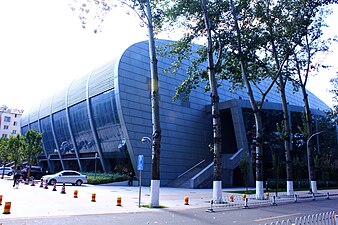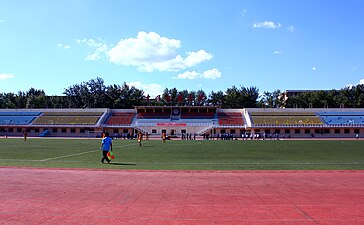China University of Geosciences (Beijing)
Coordinates: 39°58′48″N 116°20′27″E / 39.98000°N 116.34083°E
中国地质大学 (北京) | |
 | |
Former names | Beijing Institute of Geology, Beijing Graduate School of Wuhan College of Geology |
|---|---|
| Motto | 艰苦朴素 求真务实 |
Motto in English | Work hard, keep modest, and pursue truth and pragmatism |
| Type | National Public |
| Established | November 1952 |
| Chairman | Wang Hongbing |
| President | Deng Jun |
| Location | Beijing , China |
| Campus | Urban |
| Affiliations | Project 211 |
| Website | www |
The China University of Geosciences (Beijing) (simplified Chinese: 中国地质大学(北京); traditional Chinese: 中國地質大學(北京); pinyin: Zhōngguó Dìzhì Dàxué (Běijīng); abbreviated CUGB or 北京地大) is a key national university directly under the administration of the Education Ministry of the People's Republic of China. It is located in Haidian District in Beijing.[1] It is a Chinese Ministry of Education Double First Class Discipline University, with Double First Class status in certain disciplines.[2]
Campus[]
The China University of Geosciences (Beijing) is located in the original campus of former Beijing Institute of Geology, Xueyuan Road, with a concentration of 8 famous universities and academic tradition.
History[]
1952–1970: creation[]
In 1952, Beijing Institute of Geology was founded as a result of the merger of the geological departments from Peking University, Tsinghua University, Tianjin University, and Tangshan Railway College. It was among China's first 16 key universities back in the 1950s.
1970–1978: re-location[]
The university suspended operations from 1966–1970 due to the Cultural Revolution, and reopened in Jiangling County, Hubei Province, in 1970 as Hubei College of Geology. In 1975, the campus was moved to Wuhan, and the school was renamed Wuhan College of Geology.
1978–1987: reconstruction[]
In 1978, the graduate faculties relocated in Beijing under the support of Mr. Deng Xiaoping, the leader of the People’s Republic of China. In 1986, the Beijing Graduate School of Wuhan College of Geology was founded in the original campus of former Beijing Institute of Geology, Beijing.
1987–2005: revitalization[]
In 1987, Wuhan College of Geology was renamed China University of Geosciences. The China University of Geosciences has two campuses in Beijing and Wuhan respectively, both of which have independent legal personalities. In 1997, CUGB was approved as one of key universities construction of the 211 project. In February 2000, CUGB was put under the management of the Ministry of Education.
2005–present: independence[]
In March 2005, CUGB and China University of Geosciences (CUG, Wuhan) became independent educational entities. In September 2006, CUGB was established as a joint responsibility of the Ministry of Education and the Ministry of Land and Resources. At the same year, CUGB was approved included in the 985 Project Innovation Platform.
Key Disciplines[]
First class state key disciplines[]
Second class state key disciplines[]
- Geochemistry
- Paleontology and Stratigraphy
- Mineralogy, Petrology, Mineral Deposit Geology
- Geological Engineering
- Mineral Resource Prospecting and Exploration
- Structural Geology
Image gallery[]
Alumni[]
- Li Zhixin, Chinese mountaineer[4]
- Ouyang Ziyuan, chief scientist of Chinese Lunar Project
- Wen Jiabao, former premier of China
See also[]
- China University of Geosciences (Wuhan)
- Geology of China
- Wen Jiabao
- Project 211
- List of colleges and universities
- Double First Class University Plan
References[]
- ^ "Home (Chinese)". China University of Geosciences (Beijing). Retrieved 2020-08-17.
校址: 北京市海淀区学院路29号,100083 电话: 010-82322005
- ^ "教育部 财政部 国家发展改革委 关于公布世界一流大学和一流学科建设高校及建设 学科名单的通知 (Notice from the Ministry of Education and other national governmental departments announcing the list of double first class universities and disciplines)".
- ^ "Discipline Construction". CUGB.
- ^ "中国登山运动"掌门人"李志新赞扬武汉人登山精神". 长江日报. 2012-04-09. Retrieved 2018-08-29.
External links[]
- Universities and colleges in Beijing
- Project 211
- Plan 111
- Educational institutions established in 1952
- 1952 establishments in China
- Schools in Haidian District
- Geology of China







